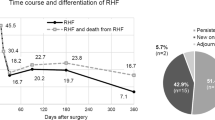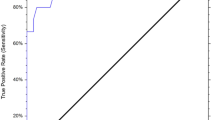Abstract
Although the right ventricular stroke work index (RVSWI) is a good index for RV function, a low RVSWI is not necessarily an indicator for the need for a right ventricular assist device at the time of left VAD implantation. We here aimed to determine a more precise indicator for the need for a biventricular assist device (BiVAD). In total, 116 patients (mean age, 38 ± 14 years), who underwent hemodynamic assessments preoperatively including 12 BiVAD patients, and had been followed at our institute from 2003 to 2015, were included. Multivariate logistic regression analysis indicated that RVSWI and pulmonary vascular resistance (PVR) were independent predictors of BiVAD requirement (P < 0.05 for both). In addition, all patients were classified into 4 groups: (1) normal (RVSWI > 5 g/m, PVR < 3.7 WU), (2) pulmonary hypertension (RVSWI > 5, PVR > 3.7), (3) RV failure (RVSWI < 5, PVR < 3.7), and (4) both pulmonary hypertension and RV failure (RVSWI < 5, PVR > 3.7), and examined. Most of the patients in Group 4 (75 %), with acutely depressed hemodynamics and inflammatory responses in the myocardium, required BiVAD. Overall, patients with BiVAD had a worse survival rate as compared with those with LVAD alone. In conclusion, high PVR in addition to low RVSWI effectively predicts BiVAD requirement.


Similar content being viewed by others
References
Slaughter MS, Rogers JG, Milano CA, Russell SD, Conte JV, Feldman D, et al. Advanced heart failure treated with continuous-flow left ventricular assist device. N Engl J Med. 2009;361:2241–51.
Shiga T, Kinugawa K, Imamura T, Kato N, Endo M, Inaba T, et al. Combination evaluation of preoperative risk indices predicts requirement of biventricular assist device. Circ J. 2012;76:2785–91.
Cleveland JC Jr, Naftel DC, Reece TB, Murray M, Antaki J, Pagani FD, et al. Survival after biventricular assist device implantation: an analysis of the interagency registry for mechanically assisted circulatory support database. J Heart Lung Transplant. 2011;30:862–9.
Fitzpatrick JR III, Frederick JR, Hsu VM, Kozin ED, O’Hara ML, Howell E, et al. Risk score derived from pre-operative data analysis predicts the need for biventricular mechanical circulatory support. J Heart Lung Transplant. 2008;27:1286–92.
Fukamachi K, McCarthy PM, Smedira NG, Vargo RL, Starling RC, Young JB. Preoperative risk factors for right ventricular failure after implantable left ventricular assist device insertion. Ann Thorac Surg. 1999;68:2181–4.
Ochiai Y, McCarthy PM, Smedira NG, Banbury MK, Navia JL, Feng J, et al. Predictors of severe right ventricular failure after implantable left ventricular assist device insertion: analysis of 245 patients. Circulation. 2002;106:I198–202.
Fitzpatrick JR III, Frederick JR, Hiesinger W, Hsu VM, McCormick RC, Kozin ED, et al. Early planned institution of biventricular mechanical circulatory support results in improved outcomes compared with delayed conversion of a left ventricular assist device to a biventricular assist device. J Thorac Cardiovasc Surg. 2009;137:971–7.
Imamura T, Kinugawa K, Nitta D, Hatano M, Kinoshita O, Nawata K, Ono M. Biventricular failure with low pulmonary vascular resistance was managed by left ventricular assist device without right-sided mechanical support. J Artf Orgns. 2015;18:272–5.
Kussmaul WG, Noordergraaf A, Laskey WK. Right ventricular-pulmonary arterial interactions. Ann Biomed Eng. 1992;20:63–80.
Saito S, Sakaguchi T, Miyagawa S, Nishi H, Yoshikawa Y, Fukushima S, et al. Recovery of right heart function with temporary right ventricular assist using a centrifugal pump in patients with severe biventricular failure. J Heart Lung Transplant. 2012;31:858–64.
Kinugawa K. How to treat stage D heart failure?—When to implant left ventricular assist devices in the era of continuous flow pumps? Circ J. 2011;75:2038–45.
Imamura T, Kinugawa K, Shiga T, Endo M, Kato N, Inaba T, et al. Novel risk scoring system with preoperative objective parameters gives a good prediction of 1-year mortality in patients with a left ventricular assist device. Circ J. 2012;76:1895–903.
Saito S, Sakaguchi T, Miyagawa S, Yoshikawa Y, Yamauchi T, Ueno T, et al. Biventricular support using implantable continuous-flow ventricular assist devices. J Heart Lung Transplant. 2011;30:475–8.
Simonneau G, Robbins IM, Beghetti M, Channick RN, Delcroix M, Denton CP, et al. Updated clinical classification of pulmonary hypertension. J Am Coll Cardiol. 2009;54:S43–54.
Zimpfer D, Zrunek P, Roethy W, Czerny M, Schima H, Huber L, et al. Left ventricular assist devices decrease fixed pulmonary hypertension in cardiac transplant candidates. J Thorac Cardiovasc Surg. 2007;133:689–95.
Matthews JC, Koelling TM, Pagani FD, Aaronson KD. The right ventricular failure risk score a pre-operative tool for assessing the risk of right ventricular failure in left ventricular assist device candidates. J Am Coll Cardiol. 2008;51:2163–72.
Imamura T, Kinugawa K, Kato N, Muraoka H, Fujino T, Inaba T, et al. Late-onset right ventricular failure in patients with preoperative small left ventricle after implantation of continuous flow left ventricular assist device. Circ J. 2014;78:625–33.
Pezzuto B, Badagliacca R, Poscia R, Ghio S, D’Alto M, Vitulo P, et al. Circulating biomarkers in pulmonary arterial hypertension: Update and future direction. J Heart Lung Transplant. 2015;34:282–305.
Kormos RL, Teuteberg JJ, Pagani FD, Russell SD, John R, Miller LW, et al. Right ventricular failure in patients with the HeartMate II continuous-flow left ventricular assist device: incidence, risk factors, and effect on outcomes. J Thorac Cardiovasc Surg. 2010;139:1316–24.
Author information
Authors and Affiliations
Corresponding authors
Rights and permissions
About this article
Cite this article
Imamura, T., Kinugawa, K., Kinoshita, O. et al. High pulmonary vascular resistance in addition to low right ventricular stroke work index effectively predicts biventricular assist device requirement. J Artif Organs 19, 44–53 (2016). https://doi.org/10.1007/s10047-015-0867-4
Received:
Accepted:
Published:
Issue Date:
DOI: https://doi.org/10.1007/s10047-015-0867-4




